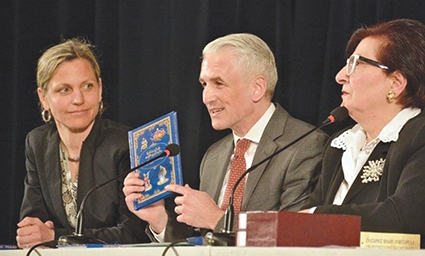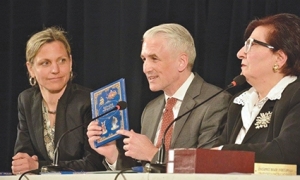The Nart Saga Adapted for Children & Published in Georgian
Presentations of the Nart Saga for Children in Georgian and Ossetian, and the third edition of the Georgian-Ossetian and Ossetian-Georgian Dictionaries, were held at Tbilisi State University on April 3.
Both projects were published by Caucasus Mosaic, a non-governmental organization, with the assistance of the European Union (EU) and the United Nations Development Program (UNDP).
The Nart Saga for Children, published for the first time in Georgian, is an adapted version of the ancient Caucasus Epos. The book is illustrated by Georgian and Ossetian artists and will be distributed in schools and libraries throughout Tbilisi and Tskhinvali.
The Georgian-Ossetian and Ossetian-Georgian dictionaries were first published in 2012 with the help of the EU and UNDP. Following their success, the third amended edition of the dictionaries was published in 2016.
The presentation event gathered representatives of civil society, Georgian government, scholars and international organizations.
“I want to congratulate our Georgian and Ossetian Research Center at the Tbilisi State University,” said Mikheil Chkhenkeli, Vice Rector of Ivane Javakhishvili Tbilisi State University, going on to thank all those involved in supporting the project. “I also want to emphasize the importance of The Nart Saga for Children being translated into Georgian and the publication of the dictionaries, and to recognize the enormous efforts made by Dr. Naira Bepieva [Caucasus Mosaic NGO] while preparing them for publication. Events like this, be they academic, research, or cultural, ensure the peaceful environment we are striving for,” he concluded.
“As our two languages developed and changed, the need to publish a new Georgian-Ossetian dictionary became obvious,” said Dr. Bepieva. “There never was an Ossetian-Georgian dictionary [until ours]. Together, we, Georgians and Ossetians, accomplished that great mission”.
She then talked about The Nart Saga for Children, adapted for younger audiences for the first time.
“The Nart Saga Epos is a treasure of the Caucasus; where you can find all the highest ideals and values of humanism, hospitality, love, and friendship; things which should be taught to children from a very early age,” she said.
Shombi Sharp, Head of the UNDP in Georgia, spoke about the joint EU - UNDP COBERM initiative that was launched in 2010, aiming to promote peace and confidence between peoples across division lines. He, too, stressed the importance of the publications.
“I’m very happy that through this project we have been able to do something for children, something very particular,” said Caroline Stampfer, Project Manager at the Delegation of the EU to Georgia. “Books are a vital part of my life and are also very important in relations with my own children,” she said.
The presentation was rounded up with a performance from popular Georgian singer Irma Sokhadze and a concert of the folk music band Mtiebi.
Thomas Wier, Assistant Professor of Linguistics at the Free University of Tbilisi, answering a question regarding the difference between Georgian and Ossetian on Quora.com:
“Linguistically, Georgian and Ossetian belong to two entirely unrelated language families: Kartvelian and Indo-European (on its Iranian branch), respectively. Although the Kartvelian languages have been situated in the Caucasus since time immemorial (at least since the early Bronze Age), the Ossetians arrived there in classical antiquity as an off-shoot of an eastern subbranch of the Iranian family within Indo-European (IE). Ossetian is specifically most closely related to Yaghnobi, a language spoken in the Pamir Mountains of Tajikistan. They are in fact the last remnants of the ancient Scythian nomads who roamed the western and central steppe more than two thousand years ago. So, despite centuries of geographic proximity, they originally come from totally different parts of Eurasia.
Grammatical (In)congruities
In many ways, Ossetic has drifted far from its IE origins. Unlike most other IE languages but like Georgian, Ossetic has lost all grammatical genders. Ossetic has also entirely lost its original IE case paradigm system, in which suffixes combined number and case in a single affix. Ossetic has instead innovated an almost entirely new system with a discrete number suffix followed by one of nine case suffixes (again, mostly unknown in IE).
See his full answer here: https://www.quora.com/How-different-are-the-Ossetian-and-Georgian-languages-and-what-are-their-origins
Nino Gugunishvili












